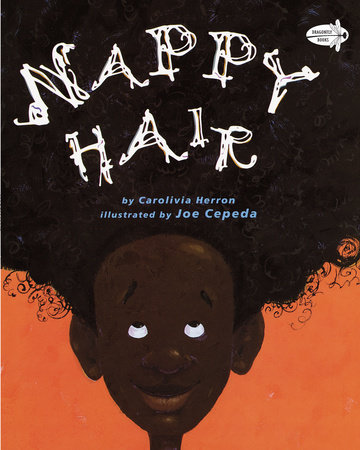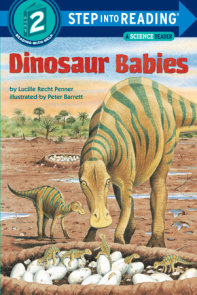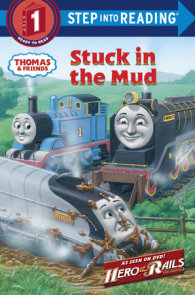TEACHING GUIDE
NOTE TO TEACHERS
The rich and rhythmic language of the text makes this an ideal book for reading aloud. Because the author uses the “call and response” style that is often used in African American storytelling and song, this is a perfect book for engaging the entire class in “performing” the story.
In addition to the obvious strength in language, Nappy Hair also asks readers to think about the themes of family, cultural diversity, stereotypes and prejudices, pride, and a sense of self. This guide includes suggestions for using this important book to connect the language arts, social studies, science, and arts curriculum.
A Note from the Author
On the Origins of Nappy Hair
Nappy Hair is a true story. I am little Brenda. Uncle Mordecai is my Uncle Richard. Different members of my family contributed different parts of the story. It’s a group poem, a group story. My mother’s line is “It’s your hair, Brenda, take the cake and come back and get the plate.” My brother thinks my hair sounds like snow, with two inches of crunchy crust on top. Think of that sound of a foot coming down on crunchy snow. My brother can actually make the sound! I recorded the story on tape, dropping out some parts and adding and editing, but the basic story was recorded.
On Call and Response
Nappy Hair is written entirely in African American call and response. I read this story aloud when I speak to educators because many people look at the text and don’t realize what’s going on. As you look at the pages you’ll see that there’s a line in standard type followed by a line in different type. The standard type is spoken by the storyteller, and that’s the call. The indented lines in different type are there to give the impression of people answering back, and that is the response.
On Self-Esteem
This story from my student is the story of every child–it is a story of self-esteem: One of my students read Nappy Hair to her 4-year-old, white, blond, blue-eyed niece and her niece said, “That little girl is just like me!” “How so?” asked her aunt. “That little girl has Nappy Hair that will never be straight and I have really straight hair that will never be curly–and mommy keeps telling me that she loves my hair and God loves my hair. We’re just alike.
ABOUT THIS BOOK
In the “call and response” style of African American story and song, Nappy Hair presents a character whose family helps her appreciate her curly, “nappy” hair and take pride in her African heritage.
At a family picnic, Uncle Mordecai tells Brenda the story of her “nappy” hair and the entire family joins in! Filled with rich, figurative language and told with the rhythm of African American poetry and song, Brenda’s story reveals a strong character with a keen sense of pride in her African heritage. Proud that she has the “twistiest hair in the whole family,” Brenda and her family celebrate each curl with a tremendous amount of self-confidence and self-respect. Revealing a powerful spirit, Brenda rollicks through each portion of her uncle’s story and takes a final bow when he states, “And she’s got the nappiest hair in the world.”
ABOUT THIS AUTHOR
Author Carolivia Herron is a novelist and a multimedia developer, and is involved in Jewish-African studies. The idea for Nappy Hair grew from her own childhood when her own family made fun of her “Nappy Hair.” Ms. Herron has a doctorate in comparative literature from the University of Pennsylvania. Nappy Hair is her first story for children.
Illustrator Joe Cepeda studied engineering at Cornell University and received his bachelor of fine arts degree at Long Beach State in California. Kirkus Reviews has praised Cepeda for his “brilliant use of color, form and perspective” in his illustrations. He lives with his wife and son in Rosemead, California.
TEACHING IDEAS
PRE-READING ACTIVITY
Ask students to each bring a baby picture to class and compare and contrast their baby hair. Ask them to describe their hair now. What is the color? Is it long or short? Straight or curly? Does their baby picture reveal anything about the type of hair they have today? Hair is something that children inherit from their parents. Ask students to share who in their family has similar hair. How is it possible for children in the same family to have different hair?
THEMATIC CONNECTIONS
FAMILY–Ask students to write their definition of family. How do they know Brenda is close to her family? Discuss the difference between an immediate and an extended family. Have students draw and label a picture of their extended family at a special family gathering. Give them the opportunity to share their picture and tell about their family.
CULTURAL DIVERSITY–Brainstorm things that all children have in common regardless of race or culture. What might Brenda teach someone from another culture
who feels different? Have students research the many different cultures that exist in the United States. How does cultural diversity make our nation a better place?
STEREOTYPES/PREJUDICE–Engage the class in a discussion about the meaning of the words stereotype and prejudice. Encourage students to talk with their parents or other adults about common stereotypes (e.g., “dumb blonde”). Is Brenda’s “nappy” hair a stereotype or a characteristic? Why is it wrong to stereotype people? How can that lead to prejudice? How can knowing a person from the inside change attitudes about stereotypes?
PRIDE–Ask students to locate places in the book that indicate Brenda is proud of her African heritage. She feels that her hair is a very special part of her culture. How do you know that she is not interested in changing her hair? Pride comes from within a person. How can a person outwardly show pride? Allow students time to share something about themselves that makes them proud.
SENSE OF SELF–Ask each student to draw a self-portrait. Then pair the students and have them draw a picture of their partner. When finished, have students compare and contrast their self-portrait and the picture drawn by their partner. Engage the class in a discussion about whether their self-portrait or the picture drawn by their partner reveals how they may be feeling.
CONNECTING TO THE CURRICULUM
LANGUAGE ARTS–The text in Nappy Hair is written in dialect. Have the class rewrite a portion of the text in Standard English. How does this change the flavor and tone of the book? What does Uncle Mordecai mean when he says that Brenda “talks the king’s English”? As author Carolivia Herron notes, this is one of the most important pages of the text for teachers: “Here is a man who obviously cannot speak standard English, and he’s praising someone who can speak standard English.”
Almost everyone has tangled hair at some time. Uncle Mordecai says that combing Brenda’s hair is like “crunching through snow.” Ask each student to write a simile that best describes combing his or her tangled hair. Make a bulletin board titled “Tangled Hair” and feature the similes written by the students.
ART–Ask students to study the illustrations in the book. How do the color tones change in the scenes of Africa? How does the artist show that Brenda is having a rollicking good time at the family picnic? Tell how the motion and movement of the illustrations resemble a dance.
Sometimes artists use exaggeration to draw the readers’ focus to a specific place on the page. Locate places in the book where Joe Cepeda uses exaggeration in his illustrations. What is a caricature? Ask students to create a caricature from their self-portraits. Then have them explain the exaggeration they featured in their caricature.
SCIENCE–Have students examine one of their hairs under a microscope or with a magnifying glass, asking them to describe the shape of the hair follicle. Then allow students time to examine the hair follicles from their classmates. What conclusion can be drawn from such an experiment?
MUSIC–Have the class listen to a blues song. Then discuss how the music makes them feel. How does the text of Nappy Hair remind them of a blues song?
Talk with the class about the development of rap music. Divide students into small groups and ask them to perform the text of the book as a rap.
THEATER/CREATIVE DRAMA–Explain that Nappy Hair is written as African American call and response. This type of storytelling was created by slaves in the 1800s. Participants would use their voices to express how they were feeling at that moment, changing the volume or rhythm to fit the mood.
As author Herron suggests, have one person read Uncle Mordecai’s lines; he’s the storyteller and that’s the “call.” Another person or group reads the responses, the lines that are printed larger and bolder; this gives the impression of people answering back, and that is the “response.” Ask students if they can hear the rhythm of the language as the poem is performed. How does using call and response allow everyone to become involved in the enjoyment of the language? You may try this with a poem by Lucille Clifton, Eloise Greenfield, or Nikki Giovanni.
VOCABULARY
While Carolivia Herron’s text is relatively simple, there are a few words that should be discussed with the class. Such words include willful, intentional, brogans, ornery, innocent, and express.
AWARDS
A Marion Vannett Ridgway Honor Book
A Parenting Reading Magic Award
REVIEWS
“Ebulliently illustrated . . . and great fun to read aloud.”–The New York Times Book Review
“The call-and-response is glorious.”–The Bulletin
OTHER TITLES OF INTEREST
RELATED TITLES
by theme
Hairs/Pelitos
Sandra Cisneros
Illustrated by Terry Ybáñez
0-679-89007-6
Dragonfly
Grades 1-3
Cultural Diversity / Acceptance
This Is My Song: A Collection of Gospel Music for the Family
Vy Higginsen
0-517-59492-7
Crown
Grades 3 up
Cultural Diversity / Pride
Tar Beach
Faith Ringgold
0-517-58030-6
Crown
Grades 3-6
Cultural Diversity
COPYRIGHT
Prepared by Pat Scales, Director of Library Services, the South Carolina Governor’s School for the Arts and Humanities, Greenville.
×
Become a Member
Just for joining you’ll get personalized recommendations on your dashboard daily and features only for members.
Find Out More Join Now Sign In





















